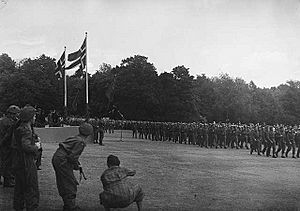Milorg facts for kids
Milorg was a secret military group in Norway during World War II. Its name is short for "military organization." Milorg was the main group that resisted the German occupation of Norway.
Their work included many important tasks. They gathered information about the Germans, carried out secret attacks (called sabotage), and helped bring supplies into the country. They also rescued Norwegian prisoners and helped people escape to neutral Sweden.
Contents
History of Milorg

After Germany took over Norway in April 1940, Milorg was formed in May 1941. It brought together different groups who wanted to fight back.
At first, Milorg did not work closely with the British organization called Special Operations Executive (SOE). SOE helped resistance groups in countries occupied by Germany. This lack of teamwork sometimes caused problems.
However, by the end of 1942, Milorg and SOE started to work together. This made their efforts much stronger.
Milorg was careful at the beginning because they feared German revenge. For example, in 1942, the Germans destroyed a village called Telavåg as punishment for resistance actions. But as the war went on, Milorg became much more active.
By the summer of 1944, Milorg had set up its first permanent bases. When Germany surrendered on May 8, 1945, Milorg had trained about 40,000 soldiers. These soldiers played a big part in helping Norway become stable again after the war.
Secret Radio Stations
Milorg used secret two-way radio stations to communicate. These stations were very important for sending messages abroad. About 20 of their 80 radio stations were discovered by the Germans. This led to at least 20 radio operators being killed or captured.
For example, a radio station at a hospital in Oslo was raided in April 1944. Another station, called "Corncrake," was raided in July. Despite the dangers, these radio stations helped Milorg become a key part of the Norwegian resistance leadership.
How Milorg Was Organized
Milorg was set up with a main council and 14 different districts across Norway.
- The Council: This was the top leadership group. It usually had 2 to 4 members.
- Central Leadership (SL): This group worked under The Council and helped manage daily operations.
Military Committee
A special Military Committee also worked under The Council. It helped plan military actions.
Milorg Districts
Milorg divided Norway into different areas called districts.
- District 13 covered the Oslo region.
- D-18 was in Sørlandet, a region in Southern Norway.
By the summer of 1942, Milorg had about 20,000 people involved across these districts.
Helping People Escape
Milorg also had special groups that helped people escape from Norway to other countries. One of these groups was called "Edderkoppen," which means "The Spider."
Important Milorg Members
Many brave Norwegians were part of Milorg. Here are some of them:
- Lorentz Brinch
- Arne Laudal
- Knut Møyen
- Terje Rollem
- Reidun Røed
- Hjalmar Steenstrup
- Andreas Tømmerbakke
- Herman Watzinger
- Eva Kløvstad: She was a District Chief for D-25, using the codename Jakob.
- Elsa Endresen: Her codename was Lotte. She took on very dangerous tasks.
- Josef Haraldsen: He was the District Chief for Vestfold. After the war, he served in the Home Guard.
See also
- Norwegian heavy water sabotage
- Norwegian resistance movement


